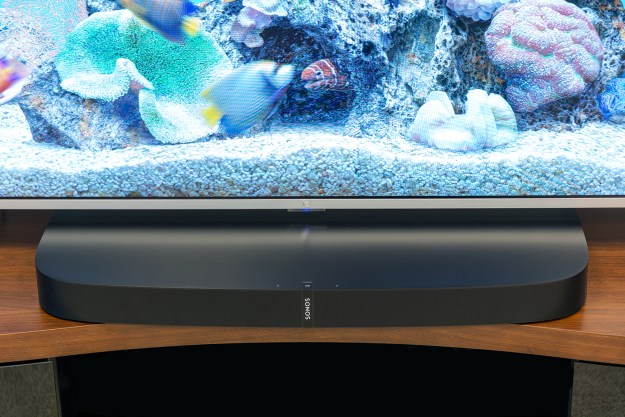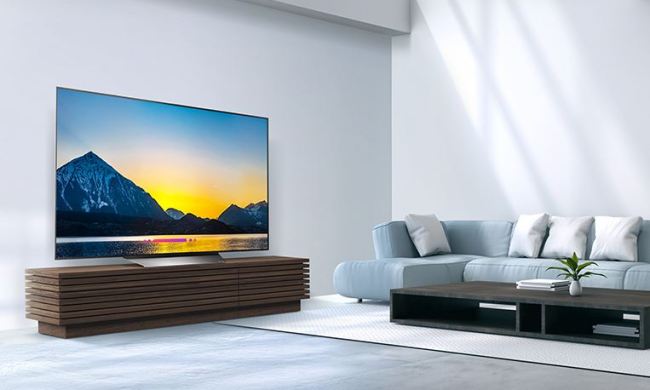
- High-impact bass
- Wide sound field
- Great stereo effects
- Dead simple to use
- Add Sonos speakers for 5.1 system
- Limited inputs/ relies on TV audio output quality
If you’re going to wall-mount your TV, Soundbars are a great way to beef up your new ultra-thin set’s equally thin sound quality. But for those of us going with a more traditional entertainment stand setup, a soundbar may not be the best choice – all but the lowest-profile soundbars have a way of getting in the way of at least a sliver of the lower portion of a TV’s screen, and many can block the infra-red sensor which lets us use our remote controls. That’s where soundbases come in.
A soundbase aims to either pull double duty as a sound source while acting as a platform for your TV, or slip conveniently under your display. You’d think such a practical product would be a slam dunk, yet the soundbase seems to have had a tough time catching on. Perhaps that’s because, so far, the soundbases we’ve seen have been a little underwhelming. Yamaha, Sony, and a handful of others have given them a shot, but in our own reviews here at DT, we’ve not been all that impressed. Until now.
Introducing the Sonos Playbase, perhaps the best reason yet to consider a speaker that is literally off the wall.
Out of the box
If there’s an audio version of unboxing a MacBook Pro, it’s the Sonos Playbase.
Features and design
The Playbase strikes you as an impossibly flat speaker — at just 2.28 inches high, it’s hard to imagine it could sound big, considering the largest driver in its forward-firing array could ever be is 2 inches in diameter. Sonos works its magic with six mid-range drivers and three tweeters, plus one invisible subwoofer placed deeper inside the cabinet. Each of those drivers gets its own Class-D amplifier, for 10 digital amplifiers in total.
The Playbase stretches 28.35 inches wide and just shy of 15 inches deep, making it large enough to accommodate many popular TV base designs, yet narrow enough to slip in between those with legs positioned at the far sides of the screen. The Playbase can handle up to 70 pounds, while it weighs just 18.85 pounds itself.
The Playbase strikes you as an impossibly flat speaker
As for convenience features specific to the Playbase: Sonos allows you to adjust bass and treble independently, add dialog enhancement, and engage a night-listening mode for those times when sudden swings in volume (A.K.A dynamics) are not desired.
Outside of those Playbase-specific options Sonos provides everything a
Sonos Trueplay – the company’s auto-tuning app – is also available.
Setup
If superior sound is the heart of Sonos’ overall design philosophy, simplicity is the backbone of its user experience. To get the Playbase ready for action, simply plug it into a wall outlet and connect a provided optical digital audio cable to either your TV’s optical audio port, or to that of an external device like a Roku or Apple TV, cable/satellite box, or Blu-ray player. For most users, a direct connection to the TV makes the most sense as all audio passed to the TV via HDMI will be sent down along this optical cable, though not necessarily at the same quality – more on this in a moment.
Once plugged in, the Playbase is ready to be set up using Sonos’ app for iOS and Android. Navigate to add a speaker, and the app will find the Playbase ready to be set up. After a brief update, the Playbase will be integrated into your Sonos network, connected to your internet router, and ready to use. Yes, it’s really that simple.
For those who wish to use the Playbase as the centerpiece of a wireless surround system (aside from the power cables, of course) any Sonos speaker can be used as a wireless surround channel (though the $200 Play:1 is the ideal candidate), while a Sonos SUB can be added to bring more authority to the bass and provide more visceral low frequency effects. Getting any of these additional speakers integrated is similarly simple. We added two Play:1 speakers as wireless surround channels in about 2.5 minutes. De-coupling the Play:1 speakers for use elsewhere in the home as part of a multiroom speaker system is a one-click affair.
If superior sound is the heart of Sonos’ design philosophy, simplicity is the backbone of its user experience.
Before we got to testing, we ran Trueplay, Sonos’ auto-setup program which uses an iOS or Android device’s microphone to balance the output of multiple speakers and/or adjust the speakers’ EQ to work best with the room they are placed in.
Source devices for our test included a Roku Ultra streaming box as well as Oppo’s UDP-203 4K Ultra HD Blu-ray Disc Player. We had initially connected the Playbase to a LeEco X55 4K Ultra HD TV, but were unable to get the set’s optical digital audio output to work properly.
Performance
Simply put: In terms of sound quality and ease of use, the Sonos Playbase trounces every other soundbase we’ve tested thus far, and sounds better than many of the soundbars we’ve tested, though admittedly few of them run anywhere near the Playbase’s price range.
The Playbase is meant as a TV audio companion first and a source of music second. That engineering intention played out in our testing, though the Playbase is certainly no slouch when it comes to playing music.
What strikes you first is the wealth of bass the Playbase can produce. The images below help explain why. The “subwoofer” is a relatively small driver within a restrictive space, but it is quite robust, and connected to a long, snaking port tube which tunes the bass to be powerful, deep, and surprisingly tuneful.
We know hard-core movie buffs will want to consider picking up a Sonos Sub, but we’d suggest anyone unconvinced they need a separate subwoofer to give the Playbase a shot on its own. It is surprisingly capable of delivering a high-impact movie and TV watching experience without any help. The prodigious bass aids more than just explosions and sound effects, too, rounding out the deeper end of voices and adding richness to movie scores and TV soundtracks. While watching The Story of God with Morgan Freeman we noted Freeman’s voice sounded full and natural rather than pinched or nasal as it has sounded with many other products leveraging small speakers to achieve big sound. The score to E.T. the Extra-Terrestrial, too, was well supported in the low end, with biting trombones and low string swells coming through rich and warm.
The Playbase does a great job pulling off stereo effects and anchoring dialog to the center of the screen.
While the Playbase’s handling of low frequencies is striking, it is its treatment of the midrange area that we are most impressed with. This is the meat of the frequency range where human hearing is most sensitive, and therefore it’s easy for average listeners to pick up on anything that sounds unnatural. The Playbase excels here – it’s just a very natural sounding speaker where it matters most, and we think that’s going to make the overwhelming majority of people who purchase it happy.
The treble region is where we find ourselves a little surprised by the Playbase. Generally, we really enjoy Sonos’ treatment of high frequencies – in fact, it is one of the elements of sound quality that separates Sonos from the competition. But where we would describe the Play:1 and Play:5 speakers as sounding just a bit on the sparkling side of neutral, the Playbase is decidedly more aggressive; perhaps even metallic. There’s a slight stridency to cymbals, sibilant speech, and even brass that comes off just a little too hot for our liking. It’s most obvious in music, but still present in high-frequency movie effects and dialog.
Outside of its generally solid frequency response, the Playbase does a great job pulling off stereo effects and anchoring dialog to the center of the screen. We’re surprised with the Playbase’s sound stage and the wide, expansive sound field it creates. Never mind its size — you’ll never accuse this speaker of sounding small.
That expansive sound field is further reinforced with the addition of two Play:1 speakers as surround channels. Even before we ran the Trueplay program to dial everything in, surround effects danced around the room, moving from one speaker to the next seamlessly. Once the Trueplay’s work had been done, however, the speakers virtually disappeared and all that was left was the soundtracks we were listening two. The added Play:1 speakers even made music sound better.
We wouldn’t recommend the Playbase purely as a music player. It just doesn’t live up to the other speakers Sonos produces. But as a TV companion first and music player second, it totally makes sense.
A slave to your TV
We’ve got just one major complaint about the Playbase and that is its limited input potential. With just one optical digital audio input, the Playbase is kept simple, certainly, but this also makes it a slave to your TV’s digital audio output capabilities, and sadly, that is a more limiting factor than you might think.
Few TVs pass along the Dolby Digital encoded audio signal the Playbase can decode through their optical audio ports (most of LG and Vizio’s 2017 TVs are an exception to that rule), meaning that the Playbase is going to have to do a lot of processing to make two-channel PCM audio sound like a proper surround sound program. Going forward, we expect to see Dolby support embraced by more manufacturers, but those pairing the Playbase with older TVs won’t be getting the best the Playbase offers.
Some may also balk at the Playbase’s lack of DTS audio support. Sonos says that DTS is primarily found on physical media and that Dolby is the standard for streaming media from outfits like Netflix, Amazon and Vudu, so the vast majority of listeners won’t be affected. We are inclined to agree here. For the typical
Warranty information
Sonos provides a one year warranty against defect of materials and workmanship.
Our Take
If you need something other than a soundbar or full-on component speaker system to improve your TV and movie-watching experience, the Sonos Playbase is an outstanding option. At $700 it is indeed expensive, but it sounds great, is easy to use, and it comes with the
Is there a better alternative?
No. The Playbase is the best-sounding product of its type we’ve tested. You can spend less, but you’ll sacrifice quality in the process.
How long will it last?
The lack of HDMI input is limiting, however optical digital audio connections aren’t going anywhere any time soon, so we’re not going to knock the Playbase over that concern. As for build quality, the Playbase is rock-solid and should last well into the future.
Should you buy it?
Do buy the Sonos Playbase if you don’t mind spending a little extra on the best product in the soundbase category. It sounds better than many competing (albeit slightly less expensive) sound bars, it’s extremely easy to use, and it virtually disappears in your entertainment center. The addition of additional














